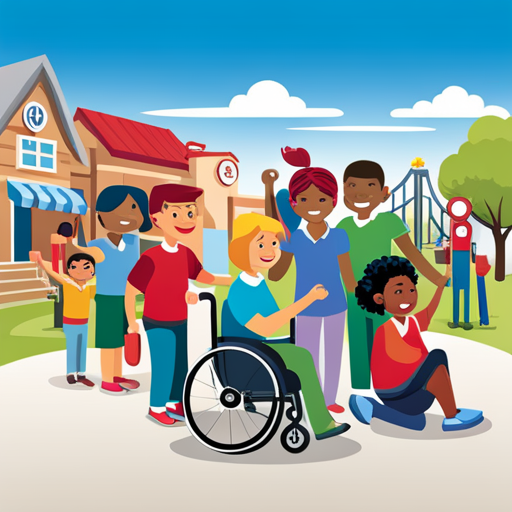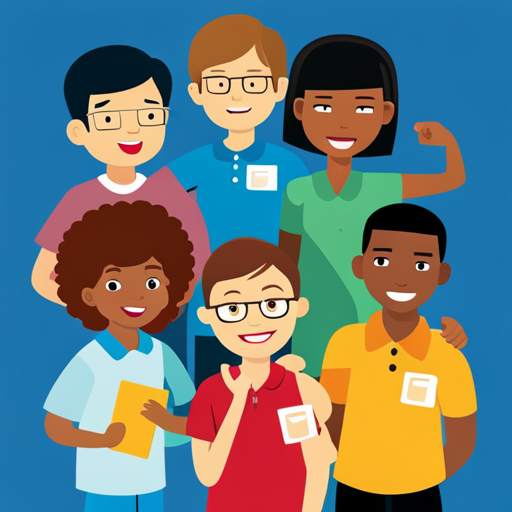"Cherishing Little Steps - A Haven for Baby and Family Journeys"
Supporting Children With Learning Disabilities
Imagine you’re on a journey through a dense forest. As you navigate the winding paths, you come across a group of children with different abilities. Some effortlessly leap over fallen branches, while others struggle to find their footing.
You observe their determination and resilience, realizing that these children have learning disabilities. Your heart fills with compassion, and you want to support them on their journey towards success.
In this guide, we will explore effective ways to support children with learning disabilities. By understanding their unique needs, creating inclusive environments, and utilizing tailored teaching strategies, you can empower these children to thrive academically, socially, and emotionally.
Together, let’s embark on this meaningful adventure of supporting children with learning disabilities.
Key Takeaways
- Learning disabilities are not indicative of intelligence or effort, but rather neurological conditions that require specific strategies and support.
- Early intervention is crucial in supporting children with learning disabilities.
- Inclusive teaching practices and differentiated instruction are essential for creating inclusive learning environments.
- IEPs and 504 plans provide accommodations and modifications to support students with learning disabilities.
Understanding Learning Disabilities
To understand learning disabilities, you need to grasp the complexities of cognitive processing differences. It can be challenging for individuals with learning disabilities to process, retain, and express information in the same way as their peers. These differences can manifest in various areas, such as reading, writing, math, or organizational skills. It’s crucial to recognize that learning disabilities aren’t indicative of a lack of intelligence or effort. Rather, they’re neurological conditions that require specific strategies and support to overcome barriers.
Understanding the challenges faced by individuals with learning disabilities is essential in providing the necessary support. Reading difficulties, for example, can make it challenging for students to comprehend texts, leading to frustration and a lack of confidence. By recognizing this struggle, educators and parents can implement strategies like using multisensory approaches or providing additional time for reading assignments. Similarly, difficulties with organization can be addressed by helping individuals develop effective planning and time-management skills.
Overcoming these barriers requires a patient and empathetic approach. It’s important to create an environment that fosters a sense of understanding and acceptance, where individuals feel safe to ask for help and advocate for their needs. By acknowledging the unique cognitive processing differences and providing appropriate support, we can empower individuals with learning disabilities to reach their full potential.
Identifying Early Signs and Symptoms

Start by observing the behaviors and academic performance of the child with a focus on identifying early signs and symptoms of learning disabilities. Early intervention is crucial in supporting children with learning disabilities, and as a parent, your involvement is key in recognizing any potential challenges your child may be facing. Here are three important signs to look out for:
-
Difficulty with reading and writing: Pay attention to your child’s progress in these areas. If they struggle with decoding words, have trouble understanding what they read, or struggle to express themselves in writing, it may be indicative of a learning disability.
-
Challenges with math: Math can be particularly challenging for children with learning disabilities. If your child consistently struggles with understanding basic math concepts, has difficulty with calculations, or has trouble solving word problems, it could be a sign of a learning disability.
-
Poor attention and focus: Children with learning disabilities often struggle with maintaining attention and focus. If your child frequently becomes easily distracted, has difficulty following instructions, or exhibits impulsive behavior, it may be worth investigating further.
Creating Inclusive Learning Environments

Observe the behaviors and academic performance of your child with learning disabilities to create inclusive learning environments. Inclusive teaching practices and differentiated instruction are key to ensuring that every child feels supported and valued in the classroom.
To create an inclusive learning environment, it’s important to understand and accommodate the diverse needs of all students. Observe how your child learns best and tailor instruction accordingly. Use a variety of teaching strategies and materials to engage different learning styles. For example, if your child is a visual learner, provide visual aids and charts to reinforce concepts. If they’re a kinesthetic learner, incorporate hands-on activities and movement into the lessons.
Differentiated instruction is another effective approach to support children with learning disabilities. This means adapting the curriculum and instructional methods to meet individual needs. Offer alternative assignments or modified tasks that allow your child to demonstrate their understanding in different ways. Provide extra support or scaffolding when needed, and give ample opportunities for practice and repetition.
Creating an inclusive learning environment also involves fostering a sense of belonging and acceptance. Encourage peer collaboration and teamwork, promoting an atmosphere of mutual respect and support. Celebrate diversity and teach children to appreciate and value each other’s differences.
Individualized Education Plans (IEPs) and 504 Plans

By implementing individualized education plans (IEPs) and 504 plans, you can effectively support children with learning disabilities. These plans are legally mandated and can provide the necessary accommodations and modifications to help students succeed in school.
Here are three key points to consider:
-
Accommodations vs modifications: IEPs and 504 plans offer different levels of support. Accommodations are changes made to the learning environment or instruction to help a student access the curriculum. This could include extra time on tests, preferential seating, or note-taking assistance. On the other hand, modifications involve altering the curriculum or grading criteria to meet the student’s needs. It’s important to understand the distinction between the two and work with the child’s teachers to determine the most appropriate supports.
-
Legal rights: Children with learning disabilities are entitled to receive a free and appropriate public education under the Individuals with Disabilities Education Act (IDEA) and Section 504 of the Rehabilitation Act. These laws ensure that students with disabilities have equal access to education and the necessary support to succeed. By understanding these legal rights, you can advocate for your child and ensure they receive the accommodations and modifications they need.
-
Collaboration: Developing an effective IEP or 504 plan requires collaboration between parents, teachers, and other school professionals. Open communication and a team approach are essential to create a plan that addresses the child’s specific needs. Regular meetings should be scheduled to review progress, make adjustments if necessary, and ensure that the plan is being implemented effectively.
Effective Teaching Strategies and Techniques

To effectively support children with learning disabilities, it’s crucial to implement effective teaching strategies and techniques. By utilizing differentiated instruction, you can tailor your teaching methods to meet the unique needs of each child. This approach recognizes that every student learns differently and requires individualized support. Through differentiated instruction, you can provide a variety of learning activities, materials, and assessments to engage and challenge all learners.
Another effective technique is multisensory learning, which engages multiple senses in the learning process. By incorporating visual, auditory, and kinesthetic elements, you can enhance comprehension and retention of information for children with learning disabilities. For example, you can use visual aids, such as charts or diagrams, to reinforce concepts. Incorporating hands-on activities and movement can also help reinforce learning and make it more memorable.
Furthermore, it’s important to create a supportive and inclusive classroom environment. Encourage collaboration and peer interaction to foster a sense of belonging and promote social-emotional development. Provide clear instructions and use visual cues to assist with organization and understanding. Additionally, regularly assess students’ progress to ensure that instructional strategies are effective and make necessary adjustments as needed.
Supporting Social and Emotional Development

You frequently need to create a supportive and inclusive classroom environment to support the social and emotional development of children with learning disabilities. It’s essential to promote self-esteem and foster friendships among these children, as it plays a crucial role in their overall well-being and academic success. Here are three important strategies to consider:
-
Encourage positive self-talk: Help children develop a positive mindset by teaching them to replace negative thoughts with positive ones. Encourage them to celebrate their strengths and accomplishments, no matter how small they may seem. By promoting self-esteem, you can empower them to overcome challenges and believe in their abilities.
-
Facilitate peer interactions: Provide opportunities for children with learning disabilities to form friendships and socialize with their peers. Create structured activities that encourage collaboration, teamwork, and empathy. By fostering friendships, you can help them develop important social skills, improve their communication abilities, and boost their self-confidence.
-
Teach emotional regulation: Help children understand and manage their emotions effectively. Teach them strategies such as deep breathing, counting to ten, or using calming techniques like listening to music or drawing. By equipping them with these tools, you can support their emotional well-being and enable them to navigate challenging situations more successfully.
Collaborating With Parents and Caregivers

Promote a collaborative partnership with parents and caregivers, fostering open communication and mutual support in supporting children with learning disabilities. Collaborating with parents and caregivers is essential in ensuring that children with learning disabilities receive the necessary support and resources they need to thrive academically and emotionally. By working together, we can create a supportive and inclusive environment that meets the unique needs of each child.
Effective communication is the key to successful collaboration. Regularly sharing information, updates, and progress reports with parents and caregivers helps them stay informed and involved in their child’s education. Listening to their concerns, insights, and feedback is equally important. By actively engaging in conversations, we can gain valuable insights into the child’s strengths, challenges, and individual learning styles.
To facilitate effective communication, consider using a variety of methods such as email, phone calls, and in-person meetings. This allows for flexibility and ensures that parents and caregivers can easily reach out whenever they’ve questions or concerns. Additionally, consider implementing a 3-column and 3-row table to document key information and action steps. This table can serve as a visual reference for both parties, ensuring that everyone is on the same page and working towards common goals.
Frequently Asked Questions
What Are the Common Misconceptions About Learning Disabilities?
Misunderstandings and stereotypes surround learning disabilities. It’s important to debunk these misconceptions and educate others. Remember, learning disabilities don’t define a person’s intelligence or potential. Everyone deserves support and understanding.
What Are Some Practical Strategies for Managing Behavior Challenges in the Classroom?
You know, managing behavior challenges in the classroom can be tough. But don’t worry, there are practical strategies that can help. Let’s explore some effective classroom strategies for behavior management together.
How Can Assistive Technology Support Children With Learning Disabilities?
Assistive technology benefits children with learning disabilities by providing tools and resources that cater to their specific needs. Implementing accommodations through technology can help them overcome challenges and succeed in their learning journey.
What Are Some Effective Ways to Promote Self-Esteem and Confidence in Children With Learning Disabilities?
You can promote resilience and build social skills in children with learning disabilities by providing a nurturing and supportive environment, encouraging their unique strengths, and offering opportunities for success and growth.
How Can Educators Support the Transition of Children With Learning Disabilities to Higher Education or Employment?
You can support the transition of children with learning disabilities to higher education or employment by providing personalized guidance and access to resources. Remember, every journey is unique, but with your help, they can find their path to success.
Conclusion
Congratulations on completing the article! You have gained valuable knowledge on supporting children with learning disabilities.
Remember, like a gentle breeze guiding a sailboat, your empathy and patience will help these children navigate the challenges they face.
By creating inclusive learning environments, utilizing effective teaching strategies, and collaborating with parents and caregivers, you’ll empower these remarkable young minds to reach their full potential.
Keep up the great work, and continue making a difference in their lives.



Thank you for your sharing. I am worried that I lack creative ideas. It is your article that makes me full of hope. Thank you. But, I have a question, can you help me?